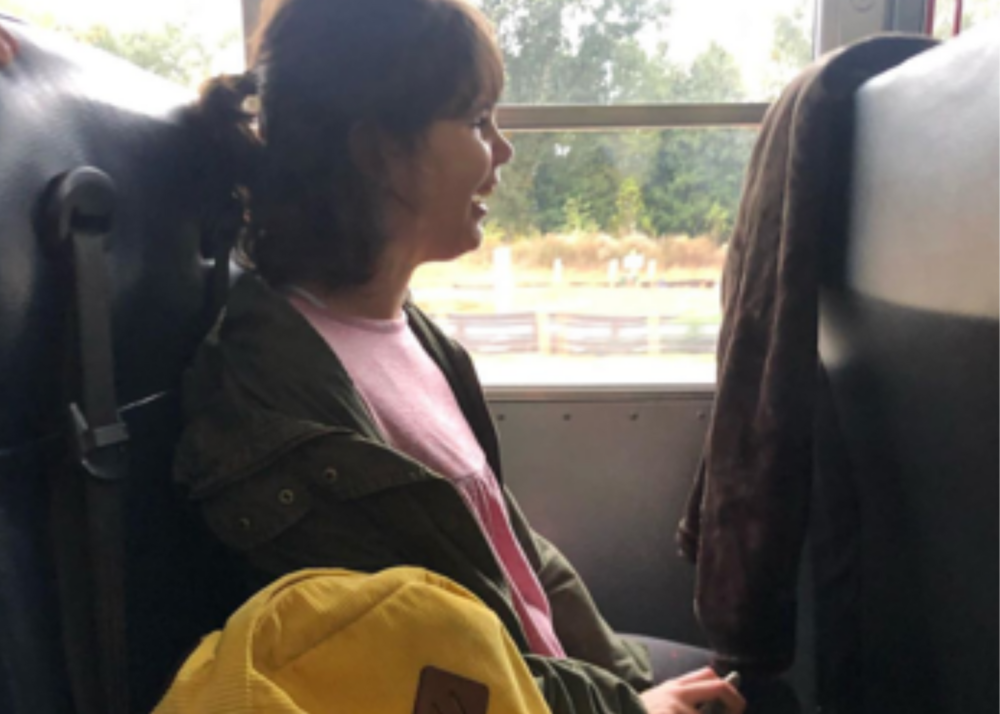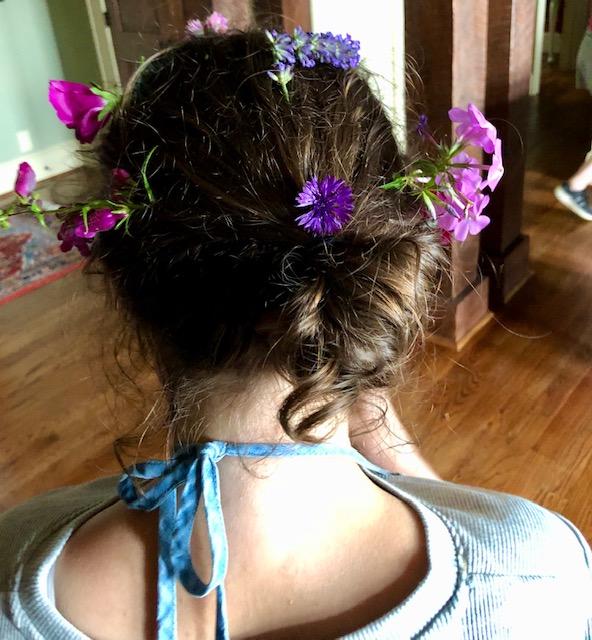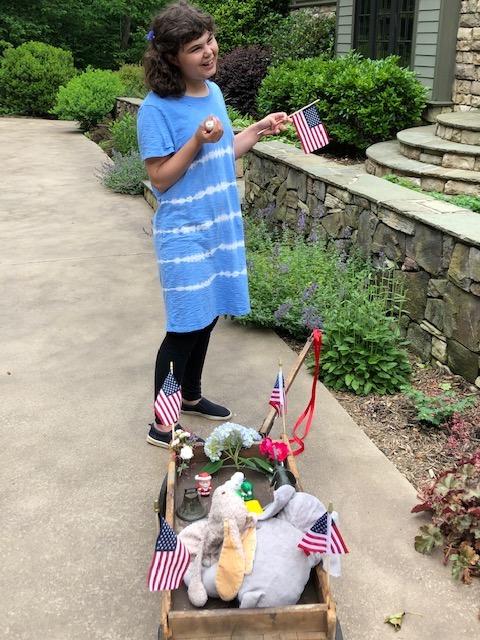Section Branding
Header Content
‘Get On The Bus? Not Today’: The Adjustment To Virtual Learning For Children With Special Needs
Primary Content
Georgia students have been out of the classroom since early March due to COVID-19. That's when the majority of students transitioned to online learning, submitting assignments virtually and attending lectures on Zoom. But for students like Sadie Boggs, a 17-year-old with autism and a chromosomal abnormality who thrives in face-to-face learning environments and the structure school provides her, virtual learning is virtually impossible.
Sadie can’t press buttons on a keyboard, click a computer mouse or stay focused in classes through a computer without assistance. Her teachers did their best to provide optional and no-fuss assignments, but she longed for her old routine of getting on the yellow school bus every day and learning in an environment designed for her specific needs.
When Sadie’s mother, Laura Boggs, and her father, Luke, first heard murmurs of coronavirus spreading to Georgia, they wondered how it was going to affect their family in Milton, a rural surburban community in Fulton County.
“My husband and I looked at each other and said, ‘Can you imagine if we have a five-month summer? Can you even imagine?’ And then, here we are.” Boggs said. “It was traumatic. It was shocking.”
Before schools shut down, Sadie learned in a self-contained classroom with six other students, one teacher, and two aides. Boggs said Sadie needs prompting — a term that refers to providing assistance or cues to encourage the use of a specific skill. Instead of asking Sadie to do a broad task such as emptying the dishwasher, for example, Boggs would ask her to perform more isolated actions. Take out the plastic cups, and put them on the counter.
Other activities such as drawing require Sadie and another person to do Hand-Over-Hand prompting (HOH), a type of physical prompting that aids in developing motor skills.
“It’s very good for Sadie to do what someone else is asking her to do,” Boggs said. “That’s the hardest thing for her, and Sadie needs that.”
The transition from Sadie’s immersive sensory education at school to trying to reach the same milestones at home was extremely difficult. Virtual learning wasn’t a part of Sadie’s individualized education plan. Sadie used an iPad at school to help her communicate wants and needs, but she can communicate verbally — and has a speech therapist — and Boggs said the iPad seemed futile. Since trying to learn from home, Boggs also doesn’t like the increase in screen time.
“It's not great for her brain to watch TV. It's not great for her brain to listen to the same songs over and over again — even though she really enjoys that — because then what happens is we just get mimicking of these things.” she said. “They get stuck.”
Boggs isn’t completely opposed to virtual learning, however, as Sadie’s adaptive physical education teacher sent physical tasks for her to complete such as throwing or rolling a tennis ball into a box to strengthen her motor skills.
Although research is slim, virtual education shows some promise in special education curriculum. Attorney at Law Jose L. Martín mentioned in his research findings “Special Education in Online and Virtual School Programs” that benefits include less stigma associated with separate school settings, greater opportunity for students to control their learning and the ease of archiving students’ work online to assess their progress.
But Sadie loves going to school. She’d wake up every morning and excitedly get ready for her day, hopping on the yellow school bus to take her to one of her favorite places. She knew exactly what to expect on each day of the week, and her routine was special to her. When schools shut down due to the spread of the coronavirus, Sadie was immediately affected and began showing drastic changes in her mood. She started crying in the morning and yearned for the school bus.
“[Sadie would say], ‘Get on the bus? Please, get on the bus? Not today,’” Boggs said.
Sadie even exhibited old and new behaviors toward herself and her parents.
“She started being aggressive with us, which we’ve seen before. That wasn’t out of the blue, but we weren’t seeing it, and now we were,” Boggs said. “And now, she started scratching the back of her own neck, which I’ve never seen before.”
Boggs and her husband used Social Stories to help Sadie process the coronavirus and why school was closed. In the first moments of transitioning to being at home, Boggs read that story to Sadie six times a day. For a while, that helped Sadie cope.
“But then the social story changed because in this social story, it said, ‘Once my school is cleaned, we will go back [to school],” Boggs said. “But that’s not how it went.”
When one of her teachers visited her at home to say hello, Sadie’s reaction was intense. It even prompted Boggs to write an opinion piece for The Wall Street Journal about virtual education and special needs.
“It did not go well because Sadie saw this person that she’s used to working with and adores,” she said. “She wanted to go to her. She actually wanted to get in her car and drive off into the sunset with her.”
Sadie followed her teacher to her car and tried to get in, flopping down onto the driveway and scraping her knees.
“It was just a reminder that we’ve destroyed your whole world, and you don’t get it,” Boggs said.
If strict regulations to reduce COVID-19 transmission continues, Boggs said she doesn’t know what her family will do.
“It will be disruptive to our jobs [and] our finances because we’ll have to piece together more help,” she said. “And then I worry about regression for Sadie.”
Developmental regression could dramatically reduce Sadie’s academic growth as well as cognitive abilities, motor skills, socialization and speech, but Boggs remains hopeful the school year will resume as normal in the fall. She’s been in communication with school board members and officials, and prospects of normalcy seem optimistic.
“I mean, they're doing the best they can to get us back,” Boggs said. “And it sounds like that will happen, barring another wave or an edict from the governor.”
Before the pandemic, she and her husband already felt stressed because they were deep in paperwork they needed to finish before Sadie turned 18 in September so that she had Social Security benefits and legal guardianship.
“We are working adults who are suddenly full-time Sadie educators, and it’s so intense [doing] all day every day Sadie,” Boggs said. “I don’t think anyone should do all day every day Sadie. It takes a village.”
Now that village is Boggs and her husband trying to simulate a routine for their daughter. They’ve planted gardens together, gone through car washes, and driven on gravel roads to see cows meandering in neighboring fields. Their family even threw Sadie a solo Memorial Day parade, a yellow school bus nestled in her wagon as a beacon of hope.
As a family, they’ve found ways to cherish moments in times of uncertainty. Boggs said they’ve bonded more, and Sadie still manages to surprise her. Walks that often fatigue Sadie because of her gait now don’t tire her out as much. She takes the lead in duets on car rides. Boggs said Sadie’s hypersensitivity to the world makes her notice the beauty in her surroundings.
“When we do walks with Sadie, she’ll say, ‘Hear the birds? Hear the birds?’” she said. “She gets me to notice things I might not notice.”
As far as school reopening in the fall, the future is uncertain and it may be too soon to predict what the outcome could be. The CDC recommends field trips go virtual, sharing of supplies such as crayons or markers is limited, and everyone wear a face covering. In the meantime, families like the Boggs are tryng to make virtual education work for them amid the COVID-19 pandemic.




